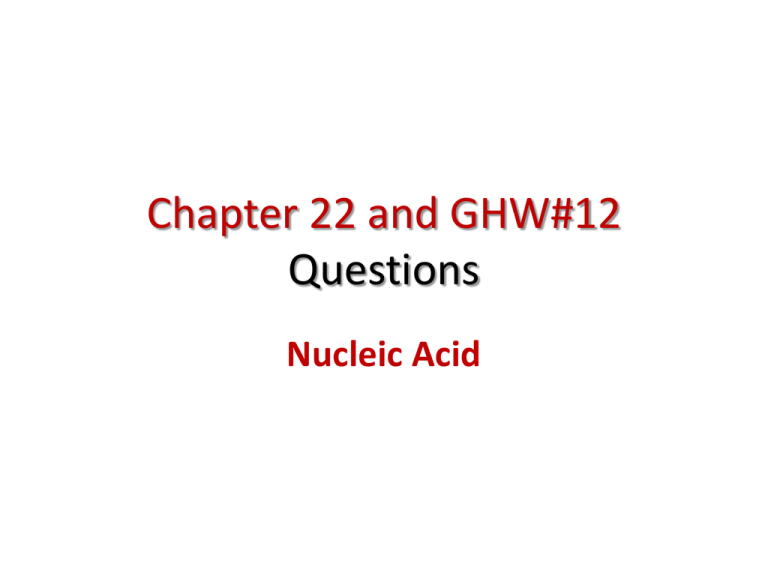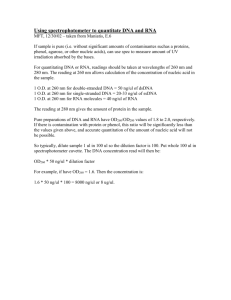GHW Questions
advertisement

Chapter 22 and GHW#12 Questions Nucleic Acid Nucleic acids A nucleic acid is a polymer in which the monomer units are nucleotides. There are two Types of Nucleic Acids: DNA: Deoxyribonucleic Acid: Found within cell nucleus for storing and transfering of genetic information that are passed from one cell to other during cell division RNA: Ribonucleic Acid: Occurs in all parts of cell serving the primary function is to synthesize the proteins needed for cell functions. Nucleotide pentose Heterocyclic Bases Deoxyribose Phosphate Ribose Nucleotide Formation Nucleotides 1) Give the names of names of pentose sugars written in Fisher projections (linear form) below 2) Give the names of names of pentose sugars written in Haworth projections (cyclic hemiacetal form) below. (Label the carbon atoms) Four types of DNA nucleotides 3) Give the names of names of bases and identify them as purines and pyrimidines (Label the atoms in the ring) Naming DNA Nucleotides Name Base Nucleoside 5'-Nucleotide 2'-Deoxyadenosine 2'-Deoxyadenosine-5'monophosphate 2'-Deoxycytidine 2'-Deoxycytidine-5'monophosphate dGMP Guanine 2'-Deoxyguanosine 2'-Deoxyguanosine-5'monophosphate dTMP Thymine 2'-Deoxythymidine 2'-Deoxythymidine-5'monophosphate dAMP Adenine dCMP Cytosine 4) a) What is phosphate and phosphate mono/di-esters? b) What is a nucleotide? c) Draw the structure of dAMP and GMP Primary Structure DNA Double Strands (secondary stucture) DNA Double Strand Complimentary Base Pair Hydrogen Bonding Weak Hydrogen Bonding 5) Draw the following a) Backbone of a nucleic acid b) DNA sequence 5'-TGA CGG TAC CC-3' 6) What are the difference between DNA and RNA? DNA number of strands sugar used bases used base pairs possible locations full name RNA Current Interests • • • • • • • • • • • DNA structure and types Gene Expression Gene Replication Genome Project Cancer and Aging Forensic and Archeology Epigenetic Biotechnology Recombinant-transgenic DNA Cloning and Stem Cell Research Bio-ethics Replications Prokaryotic Human Chromosomes Eukaryotic Gene Expression The process by which information from a gene is used in the synthesis of a functional gene product: Proteins • Transcription • RNA processing • RNA export • Translation • Folding • Protein transport Five types of RNA RNA molecules found in human cells are categorized into five major types, distinguished by their function. • Heterogeneous nuclear RNA (hnRNA), • Messenger RNA (mRNA) • Small nuclear RNA (snRNA) • Ribosomal RNA (rRNA) • TransferRNA (tRNA). RNA Functions Protein Synthesis 3-base code (triplet) is an “anticodon” Protein molecule Attached amino acid that is carried from cytoplasm to ribosomes 7) Write the type of RNA used for each of the following functions: a) Makes up parts of the ribosome b) Delivers amino acid to the ribosomes c) Codes for proteins 8) What is the name given to the short (610 bp) sequence of bases in the RNA prior to the start of transcription to which the RNA polymerase binds? 9) (a) How many nucleotides make up a codon? (b) How many different codons are there? (c) How many different amino acids are there? 10) Write the RNA sequence transcribed from the following DNA sequence. Then write the amino acid sequence of the protein translated from that RNA. 5'-TGA TTT CGG TAC GAT TAA CAA CCT CGA ATT CC-3' 11) What causes the variation in traits that is the basis for evolution? 13) (a) What is gene expression? (b) Why is gene expression regulated? 14) For each of the following mutations in the DNA sequence below, show and explain the effect that the mutation will have on the RNA and protein sequence and, if applicable, on the protein in general. (The numbers for each correspond to the arrows above the sequence.) 5'-TGA TTT CGG TAC GAT TAA CAA CCT CGA ATT CC-3' a) T in GAT is replaced by C b) T in TAA is replaced by C c) first A in TAA is replaced by G d. C in CAA is replaced by Ae) delete CAA f) delete T in GAT Epigenetics • the term refers to gene expression caused by mechanisms other than changes in the underlying DNA sequence, hence the name epi(Greek: επί- over, above). • neo-Lamarckism: genetic materials in the cytoplasm: environment led to adaptive changes that were passed on. • Genogrphics: Mitochondrial Eve The RNA Codons Polyunsaturated fatty acids: omega-3 and omega-6 fatty acids Essential Fatty Acids (EFA).



